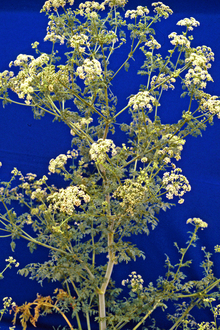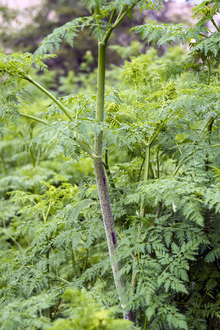Quick facts
Poison hemlock is an invasive species on the Prohibited Eradicate List. The plant must be destroyed and transportation, propagation, or sale of these plants is prohibited.
- Poison hemlock is found near railroad tracks, rivers, ditches, field edges, farms and bike paths.
- Poison hemlock should be reported.
- The Minnesota Department of Agriculture monitors this invasive species. Please report any poison hemlock you spot at Arrest the Pest.
WARNING: Poison hemlock can be deadly to humans and livestock if ingested. All plant parts are highly toxic. Protective clothing and gloves must be worn when working in an infestation.
Poison hemlock (Conium maculatum) is an invasive plant native to Europe and North Africa.
It is highly toxic and can be fatal to humans and livestock.
Poison hemlock requires considerable sunlight to flourish and is found often near railways, rivers, ditches, field edges, farms and bike paths. It is a biennial plant (having a two year life cycle), and is unlikely to grow in very shady areas or places that are frequently mowed.
How to identify poison hemlock
- Biennial herbaceous plant that starts out as a low-growing rosette and matures into a tall flowering stalk, up to eight feet.
- Highly poisonous.
Stem
- Smooth, hollow, light green stems with purple spots.
- May appear ridged due to veins.
Leaves
- Alternate, generally triangular in form.
- Doubly or triply pinnately compound, up to 18 inches long by 12 inches wide, with dark green leaves.
- Leaflets are fern-like, deeply divided and typically twice as long as wide.
- Basal leaves tend to be larger and have longer petioles than upper stem leaves.
- Petiole to stem attachments are covered by a sheath.
Flowers
- White with five small petals, cluster in an umbrella shape at the tips of branches.
- Umbels can be two to three inches across.
- Blooms May to August.
Seeds
- Round, ridged seeds are produced in abundant quantities.
- Two seeds per capsule that split at maturity.
- Each seed is flattened on one side and lined with vertical, wavy ribs.
Roots
- Taproot resembles a small white carrot or parsnip, but is deadly when eaten.
Human health impacts
All parts of poison hemlock (roots, stems, leaves and seeds) are extremely toxic to humans and livestock when ingested. Small amounts can be deadly.
This toxin impacts the nervous system causing trembling, salivation, lack of coordination, dilated pupils, weak pulse, respiratory paralysis, coma and death. Extra care should be taken to wear protective clothing and eyewear before working with or exposure to poison hemlock.
Common look-alikes
Many plants are often mistaken for poison hemlock, or vice-versa. Use this printable poison hemlock lookalikes chart (PDF) or the list below to determine if you have found poison hemlock.
These plants are natives and critical for healthy wildlife ecosystems. No management necessary.
- Angelica (Angelica atropurpurea) has purple stems and leaves are not lacy.
- Common elderberry (Sambucus canadensis) main stems are woody without purple spots.
- Common ragweed (Ambrosia artemisiifolia) leaves are very lacy but the stems are hairy.
- Tall meadow rue (Thalictrum dasycarpum) may have purple spots on green stems, but does not have lacy leaves.
- Yarrow (Achillea millefolium) leaves are very lacy but are not triangular.
Native, non-invasive plants. Part of a healthy wildlife ecosystem; should only be managed if their location poses a risk to human or livestock health. USE CAUTION and wear protective clothing if walking through or handling.
- Cow parsnip (Heracleum lanatum) does not have purple spots on the stem and it has very large lobed leaves.
- This plant’s sap causes blisters on skin when exposed to sunlight.
- Water hemlock (Cicuta maculata) stems may have purple spots, but leaves are not lacy. Highly toxic to humans and livestock.
These species are regulated noxious invasive plants, and several are toxic.
- Giant hogweed (Heracleum mantegazzianum) stems may have purple spots, but leaves are not lacy.
- Giant hogweed is a prohibited noxious invasive plant that causes painful burns and severe blistering.
- USE CAUTION and wear protective clothing if walking through or handling.
- Queen Anne’s Lace (Daucus carota; also known as wild carrot) has lacy leaves, but stem has hairs and does not have purple blotches.
- It has line-like lacy bracts under the flowers.
- A noxious invasive plant descended from domesticated carrots with an edible root.
- Wild parsnip (Pastinaca sativa) does not have purple spots on the stem.
- Another noxious invasive plant, this one descended from domesticated parsnip with an edible root.
- Like giant hogweed, wild parsnip can cause severe blistering and swelling when the sap contacts human or animal skin and is exposed to sunlight.
- USE CAUTION and wear protective clothing if walking through or handling wild parsnip to prevent these chemical burns.
Reporting poison hemlock
If you believe you have found poison hemlock, contact Arrest the Pest and send a picture of the purple spots on the stem, a leaf, and the specific location of the plant. We ask that you report the plant so that we can track the extent of the invasion and need for future control across the state.
Natural resource and other land management professionals should use the GLEDN app to report poison hemlock plants.
Once you have determined it is poison hemlock decide if you or a professional will treat the plants on your property.
Management
It is highly recommended that you call a professional to handle this plant. However, if you choose to manage poison hemlock yourself, be sure to wear gloves and other protective clothing including eye wear. Shower afterwards to be sure you have no toxic sap on your skin, and launder your clothes.
First year plants (those that don’t have flowers) can be treated at any time of year.
- They should be sprayed with herbicide, frequently mowed (ensure only non-flowering plants are mowed) or dug out and bagged in plastic.
- Herbicide is most effective on smaller first year plants early in the year.
- If left alone these plants will produce many seeds in their second year; as an invasive plant the seeds will spread and grow quickly.
April and May are perfect times to ID and spray plants of any age with an herbicide appropriate to the area, such as glyphosate or triclopyr. If using herbicide, know that it is your legal responsibility to read the label and follow the directions. April through May is a perfect time because the plants have not flowered yet and you have caught them early, avoiding a successful invasion.
If you choose a non-herbicidal route during April and May you can pull or dig out the root, being sure to take protective measures outlined above. Once it is dug out, place the whole plant in a plastic bag.
During flowering you may spray green plants with herbicide or dig the whole plant out, ensuring the flower and/or seed heads are not left on the plant or the ground.
With gloves on, cut the flower or seed heads off and place in a plastic bag. Do not mow unless flower and seed heads have been removed.
Be sure to take protective measures outlined above.
In the fall, the plants that have already flowered (second year plants) die so there is no need to dig the plant out – they will be dead by December and that plant will not return in the spring.
Dead plants remain toxic for three years. Seeds on the dead or dying plants will be viable and will germinate over subsequent years.
To stop the seeds from germinating, while wearing protective clothing and eyewear, simply cut the seed heads off. Place the seed heads in a plastic bag.
Do not mow unless flower and seed heads have been removed. The dead second year plants can be left in place as long as all the seeds are gone.
Due to seeds persisting in the soil, check the same area the next spring for dark, green lacy-leaved plants with purple spots on the stems.
If these are found please report them to Arrest the Pest and send a picture of the purple spots on the stem, a leaf, and the specific location of the plant.
Disposal
We recommend you call a professional to safely dispose of the poison plants.
- Do not compost the plants as the seed and poison will stay viable into the future and more plants will reappear later.
- Do not burn the plants as this may release the toxin.
If your garbage services accept poisonous plants (as does Dodge, Fillmore, Olmsted and Winona counties) then place the plants in plastic bags and put them in the garbage. The plastic bags will protect the health of the people who handle the garbage even after leaving your property.
If your county does not accept poisonous plants, then bury the plants, flowers and seed heads in an area that will remain undisturbed.
Emergency, livestock, and other resources
For suspected ingestion call the Minnesota Poison Control Center 1-800-222-1222
- Poison Hemlock – Information page from the Minnesota Department of Agriculture
- Midwest Invasive Plant Network – Information on how to control many invasive plants common to the Midwestern United States
- Noxious Weeds and their Look-alikes – Guide to noxious weeds by the Minnesota Department of Transportation
- Poison Hemlock Reported Distribution – Use EDDMaps to find where poison hemlock has been reported to date
- Plants Poisonous to Livestock – Information on poisonous plants from the University of Minnesota Extension Crops team
- Contact your County Weed Inspector – List of County Ag Inspectors from the Minnesota Department of Agriculture
- Poison Hemlock – Brochure from University of Minnesota Extension
- Poison Hemlock Lookalikes – Chart of poison hemlock look-alikes and their distinguishing characteristics
Reviewed in 2020




